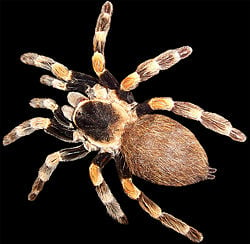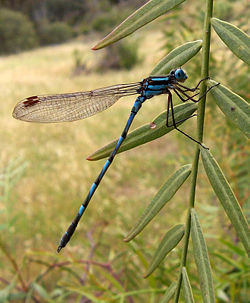Arthropod
| Arthropods | ||||
|---|---|---|---|---|
 Brachypelma smithi | ||||
| Scientific classification | ||||
| ||||
| Subphyla and Classes | ||||
NOTE: Some classification schemes group |
Arthropods (Phylum Arthropoda) (Greek "jointed feet") are the largest phylum of animals and include the insects, arachnids, crustaceans, and other similar creatures. In approximate statistics, over eighty percent extant (living today) animal species are arthropods, with over a million modern species described and a fossil record reaching back to the early Cambrian. Arthropods are common throughout marine, freshwater, terrestrial, and even aerial environments, as well as including various symbiotic and parasitic forms. They range in size from microscopic plankton (~0.25 mm) up to forms several metres long.
The arthropods have a segmented body with appendages on each segment. They have a dorsal heart and a nervous system on the ventral side of their bodies. All arthropods are covered by a hard exoskeleton that is made out of chitin, a polysaccharide. Periodically, an arthropod sheds this covering when it molts. This covering prevents the arthropod from drying out, but also prevents arthropods from growing too big. The arthropod group identified with the subphylum Chelicerata is the class Arachnida. The most familiar arachnid is the spider. These organisms have two body regions, ten jointed appendages, simple eyes, and often carry on respiration by means of book lungs. Their chelicerae are hollow fangs that pierce prey. The second appendages, the pedipalps, contain sensory receptors. They also have four pairs of jointed legs. On the tip of the abdomen of many spiders there are spinnerets, which they use to make silk for their web. Other arachnids include the scorpions, with their pedipalps shaped like pincers, and the mites and ticks, which can be destructive to both plants and animals.
Lobsters, crabs, shrimp, and barnacles belong to the class Crustacea. Their bodies are divided into three parts: abdomen, thorax, and head. Most are aquatic and use gills for respiration. The young stage is a nauplius (larva). The number and type of head appendages helps to determine the crustaceans. One typical crustacean which looks like a lobster is a crayfish. It has four pairs of antennae on its head. Large eyes are attached on the head. Behind those are its mandibles or jaws, which are used to chew food. They are helped by the two pairs of maxillae right behind them. The crayfish also has walking legs and claws on its thorax region. On the abdomen are appendages called swimmerets that females use to hold their eggs. Other groups of arthropods include the Diplopoda, commonly known as millipedes, and the Chilopoda, or the centipedes. A major difference between these groups is the number of legs on each segment.
Basic arthropod structure
The success of the arthropods is related to their hard exoskeleton, segmentation, and jointed appendages. The appendages are used for feeding, sensory reception, defense, and locomotion.
Most arthropods respire (breathe) through a tracheal system (an exception being Pauropoda); a potential difficulty considering that the skeletal structure is external and covers nearly all of the body. Aquatic arthropods use gills to exchange gases. These gills are specialized with an extensive surface area in contact with the surrounding water. Terrestrial arthropods have internal surfaces that are specialized for gas exchange. The insects have tracheal systems: air sacs leading into the body from pores, called spiracles, in the epidermis cuticle.
Arthropods have an open circulatory system. Hemolymph, a copper-based blood analogue, is propelled by a series of hearts into the body cavity where it comes in direct contact with the tissues. Arthropods are protostomes. There is a coelom, but it is reduced to a tiny cavity around the reproductive and excretory organs, and the dominant body cavity is a hemocoel, filled with hemolymph which bathes the organs directly. The arthropod body is divided into a series of distinct segments, plus a presegmental acron which usually supports compound and simple eyes and a postsegmental telson. These are grouped into distinct, specialized body regions called tagmata. Each segment at least primitively supports a pair of appendages.
The cuticle in arthropods forms a rigid exoskeleton, composed mainly of chitin, which is periodically shed as the animal grows. They contain a inner zone (procuticle) which is made of protein and chitin (a polysaccharide) and is responsible for the strength of the exoskeleton. The outer zone (epicuticle) lies on the surface of the procuticle. It is nonchitinous and is a complex of proteins and lipids. It provides the moisture proofing and protection to the procuticle. The exoskeleton takes the form of plates called sclerites on the segments, plus rings on the appendages that divide them into segments separated by joints. This is in fact what gives arthropods their name—joint feet—and separates them from their very close relatives, the Onychophora and Tardigrada. The skeletons of arthropods strengthen them against attack by predators and are impermeable to water. In order to grow, an arthropod must shed its old exoskeleton and secrete a new one. This process, molting, is expensive in energy consumption. During the molting period, an arthropod is vulnerable. Once their cuticle hardens they are fully developed and can never grow again. Their cuticles slowly expand as they increase in mass. They breakdown (digest) their cuticle every now and then when they need to grow. Their cuticle hardens at their adult size and they slowly grow to fill it up.
Arthropod relationships
At one point it was considered that the different subphyla of arthropods had separate origins from segmented worms, and in particular that the Uniramia were closer to the Onychophora than to other arthropods. However, this is rejected by most workers, and is contradicted by genetic studies.
Traditionally the Annelida have been considered the closest relatives of these three phyla, on account of their common segmentation. More recently, however, this has been considered convergent evolution, and the arthropods and allies may be closer related to certain pseudocoelomates such as roundworms that share with them growth by molting, or ecdysis. These two possible lineages have been termed the Articulata and Ecdysozoa.
The classification of the arthropods varies somewhat from source to source. There are five main subgroups: the Trilobita, Chelicerata, Myriapoda, Hexapoda, and Crustacea, which may be variously ranked from subphyla to classes, with various other taxa introduced above or below them and corresponding changes in the ranks of their subgroups. Here we have followed a "splitting" taxonomy, containing only generally accepted groups and assigning them higher ranks.
Aside from these major groups, there are also a number of fossil forms, mostly from the lower Cambrian, which are difficult to place, either from lack of obvious affinity to any of the main groups or from clear affinity to several of them.
See also:
External links and references
Template:Dichotomouskey
- The Arthropod Story (from Understanding evolution @ Berkeley.edu)
- http://www.itis.usda.gov ITIS TSN: 82696
- http://www.peripatus.gen.nz/Taxa/Arthropoda/Index.html Campbell, Reece and Mitchell. Biology. 1999
- Do spiders have hydraulic legs? (from The Straight Dope)
Credits
New World Encyclopedia writers and editors rewrote and completed the Wikipedia article in accordance with New World Encyclopedia standards. This article abides by terms of the Creative Commons CC-by-sa 3.0 License (CC-by-sa), which may be used and disseminated with proper attribution. Credit is due under the terms of this license that can reference both the New World Encyclopedia contributors and the selfless volunteer contributors of the Wikimedia Foundation. To cite this article click here for a list of acceptable citing formats.The history of earlier contributions by wikipedians is accessible to researchers here:
The history of this article since it was imported to New World Encyclopedia:
Note: Some restrictions may apply to use of individual images which are separately licensed.

